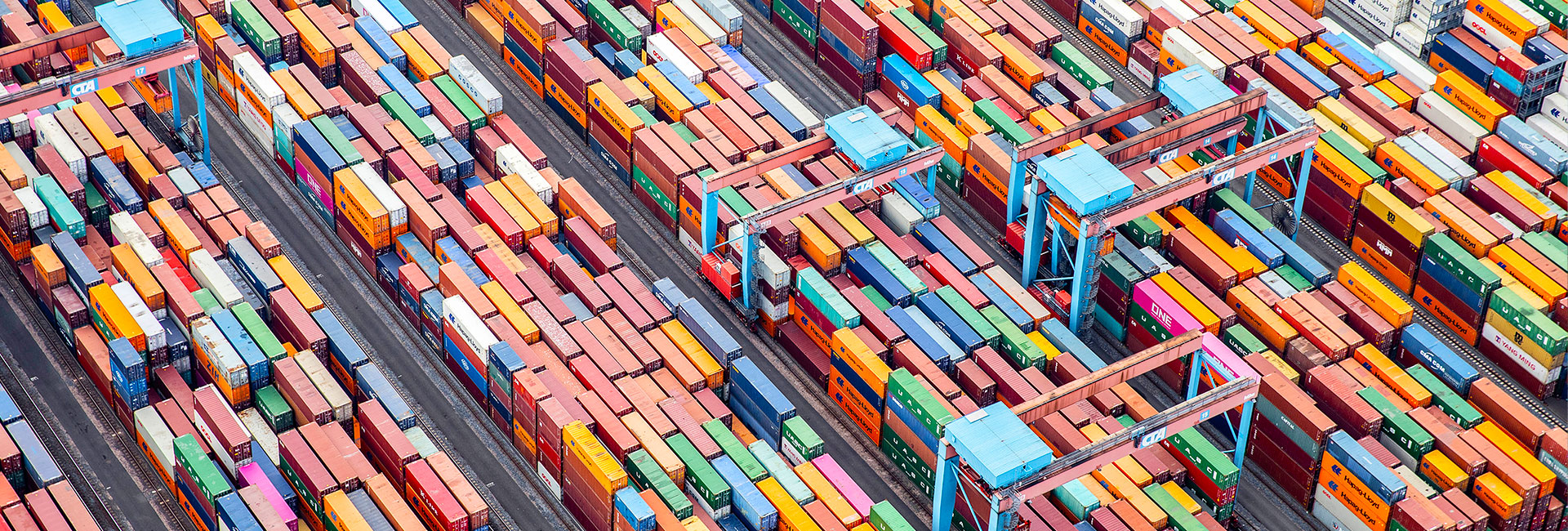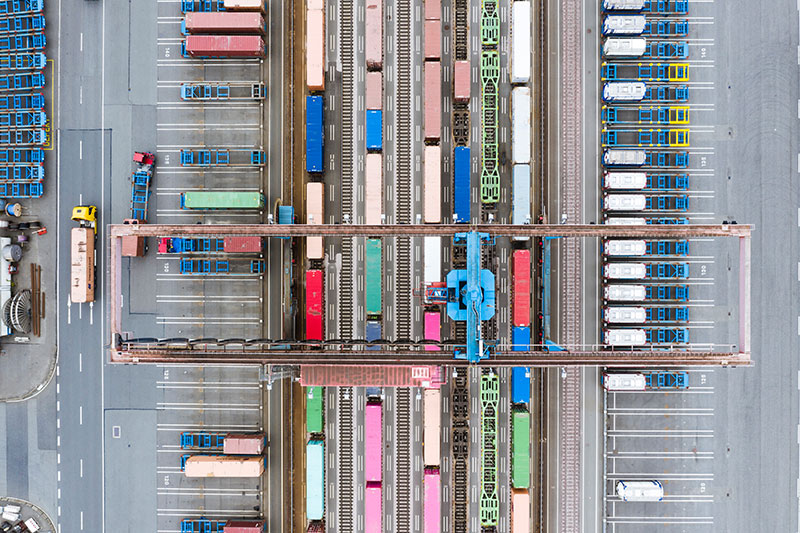News
24 Jun 2020
HHLA Container Terminal Altenwerder: CTA recertified…
• Carbon footprint at CTA reduced by a further 6.4 percent … • TÜV Nord confirms climate neutrality of facility … • Chairwoman of the Executive Board, Angela…

At the CTA – HHLA Container Terminal Altenwerder rail sidings, the portal of rail crane 04 extends over and beyond the nine fully occupied tracks. Weighing 500 tons, this piece of technology shifts itself into the correct position above a still half-empty, stationary train below. A steel box weighing several tons hangs from its rotating trolley. This must be lowered precisely on to a flat container railcar. The castings at the corners of the container slip into the four corner fittings on this railcar. The rail crane performs very well here, feels Jan Kämena. This CTA operative is sitting in the container gantry crane cabin. He’s supervising a test concerning automation of rail handling at CTA. Even on entering service in June 2002, this Port of Hamburg terminal was the most highly automated in the world. CTA remains a model project, and the rail gantry crane aims to advance its development a step further. With support from the Federal German IHATEC – Innovative Port Technologies program, CTA’s developers aim to find solutions enabling men and machines to interact in automated operation.
To enable the facility to spot people and vehicles, it is equipped with 30 real-time scanners that can handle up to 26 million pixels per second. These produce 3D scans of the relevant environment, constantly matching a piece of software with the correct state. Should it spot unknown objects, it stops the crane. Located in CTA’s office block, in future remote controllers will each be supervising and controlling several rail gantry cranes. The great majority of standardized handling processes at the station will then be automated. Also involved in the project is iSAM, a specialist in automation technology much in demand worldwide, and since 2020 part of the HHLA Group. “When we opted to get together with HHLA, it was precisely alliances of this kind that were our strategic aim,” explains Bernd Mann, iSAM’s chairman. The company’s focus has so far been on equipping mines and bulk cargo terminals. In the Port of Hamburg, Hansaport as the largest German coal/ore terminal is one of the model projects for the company, which is based at Mülheim on the Ruhr. After bulk cargoes, containers are now firmly in the sights of the iSAM specialists.
Their size makes seaports more suitable for scaling than smaller rail and inland waterway vessel terminals, says Mann. Given the immense expense, automation only pays off for larger facilities. “Only a small number of technical limits restrict our solutions, but there are quite a few economic ones,” says the iSAM supremo. As CTA demonstrates, ports are no laggards in the worldwide mega-trend towards automation. Yet some other logistics areas have already taken this still further. Intra-logistics is one example, with its gigantic high-bay warehouses and standardized processes that are simpler to automate. Automated drones flying by night even sort out inventories.

Only a small number
of technical limits
restrict our solutions,
but there are quite a
few economic ones,
Barely anybody is more aware of the motivation behind such far-reaching steps in automation than Bernd Mann. Even as an undergraduate, his main field was automation technology. He started with iSAM in 1993, and has been Executive Board member responsible for development and technology since 2002, becoming chairman in 2020. In his experience, lack of experts frequently compels his customers to automate processes and procedures. This can also improve staff working conditions. “Younger colleagues, especially, find cooperating on a remote-control console attractive,” says iSAM’s top executive. “They prefer working in an air-conditioned office, with a coffee kitchen next door, to spending a shift alone and having to climb up a giant device in all weathers.” Mann knows from his experience in Australia that a remote operation center can produce new prospects, for example, when staff are sought for remote and unpopular areas. To a great extent, mining operations out there can be controlled from a distance. “These employ hundreds of workers, who no longer need to commute. This has numerous advantages for their families and the environment,” says the head of iSAM.
In high-wage countries, among them Australia and those in the EU, such jobs are more secure in the long term, being more productive and therefore more competitive. Mann is aware of another important reason for the onward march of automation: “The strain on technology is milder than if a human being is handling it. Then this usually very costly equipment last longer.” In addition, their performance can be monitored continually, simplifying planning and making them easier to embed in complex terminal processes. The Chairman of iSAM-Chef concedes that as a result of automation, in some areas fewer staff are required. Yet he sees fresh employment opportunities in terminal operations: “Nobody in the ports any longer yearns to have to drag around heavy sacks. It is primarily the less attractive jobs that will disappear. Sufficient work remains, yet this tends to be in areas such as design, management, supervision and maintenance.”
The question remains, where are the frontiers of automation? The answer is reassuring: “Computers cannot solve any problems. In tricky situations, humans are more efficient. They can use their experience to make transfers, i.e. make decisions beyond the scope of programmable routines.” Computers would not be capable of finding creative ‘diversions’ or of deciding between two poor solutions, according to the iSAM chief’s analysis. In such situations people seek compromises, e.g. to complete unloading of a ship punctually. Sometimes, fifty boxes have to stay put or be trucked to the next port . Humans remain indispensable, not just for overcoming crises and exceptional situations, but also primarily for new ideas and creative improvements, for planning and setting priorities. Increasing utilization of intelligent machines can help in shaping a sustainable future. The next challenge also beckons at the Port of Hamburg’s CTA: one after another, even the container gantry cranes will be automated.
Based in Mülheim on the Ruhr, iSAM was founded in 1983. The company employs almost 50 staff there and has branches in the USA, Australia/Asia and Canada, its core markets. Operating worldwide, the company specializes in automation technology.
iSAM has succeeded in completely automating waterside loading/unloading cranes for bulk cargoes. Automatic discernment of ship movements and operation of load-handling devices is one key technology here. iSAM therefore has the building blocks for fully automating a container gantry crane.